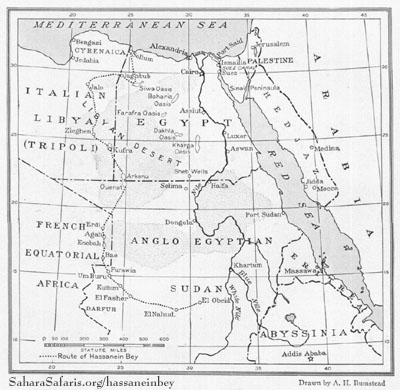National Geographic article about Hüsnü (actually
'Hassanein') Bey's trans-Libyan desert trek. So, TNT
will defer to the original, which is much more thorough
and contains Hassanein Bey's photographs.
It should be noted that the expedition occurred in the first
6 months of 1923, rather than in the year 1925, which
TNT wrongly deduced from the reference to "last year"
in the 1926 Istanbul newspaper's article. Mea culpa mea
culpa mea maxi meculpa.//
http://www.saharasafaris.org/hassaneinbey/ngs1924article.htm
Vol. XLVI, No. 3 WASHINGTON September, 1924
The National Geographic Magazine
CROSSING THE UNTRAVERSED LIBYAN DESERT
The Record of a 2,200-Mile Journey of Exploration which Resulted in
the Discovery of Two Oases of Strategic Importance on the Southwestern
Frontier of Egypt
By A. M. Hassanein Bey
With Illustrations from Photographs by the Author

Follow the dotted line for the path of Hüsnü (Hassanein) Bey's
caravan from Sollum on the Mediterranean coast to El Obeid
in Sudan.
"Sometimes, after having battled the ferocious weather for hours,
suddenly towards sunset the wind dies down, as if by the magical
command of a secret hand. Then, for an hour or so fine sand falls like
a summer fog. Next, under the mysterious light of the rising moon
the desert takes on a bewitching form, making one wonder weather
there had even been a sand storm at all. Memories are erased. How
could it be that this silent, peaceful setting, the stuff of poetry, could
have, hours earlier, been so cruel?"
Upon reaching Jalo, the main oasis of the Libyan desert, provisions
are replenished. This place is important both because of its geographic
location and its dates. In other words, it is a transit point through
which caravans pass en route to Benghazi and Egypt, carrying ivory
and ostrich feathers. The trade is under the control of the Majabra tribe.
In fact, every member of the tribe takes pride in the fact that his father
died in the camel saddle, much like warriers who fall in battle.
Hüsnü Bey's caravan is comprised of 15 people, 37 camels, a horse
named Baraka and colt named Bibu. As for equipment, there are 4
tents, four cameras, a cinematograph 'prezdevu' machine, a
chronometer and 'tudevlit'. Of course, the pictures he takes cannot be
developed, for lack of water.
With regard to the paucity of water in the desert, Hüsnü Bey had this
to say:
"All the way from Sellum to El-Ubeyd, we never had even one cup of
clear water to quench our thirst. The water in the tarcloth and sheepskin
pouches we carried absorbed some of the tar, hairs and other foreign
matter from the pouches. There has been a lot of misinformation up to
now about the amount of water desert travelers consume. In winter,
a cup of water in the morning and the evening is sufficient. If we walk
in the sunlight, then a third cup is required but drinking extra water is
ridiculed as a "woman's weakness".
"When the hot weather returns, we rest during the day and travel at
night to conserve water. But my horse needs a third of the water pouch.
A desert traveler's food is made up of rice, flour and dates. To these
ingrediants the Bedouins add sheeps milk to make a meal that is quite
bitter, so melted butter must be added to it.
One of the Bedouins' refreshments is tea: a handful of sugar and a
handful of tea are added to half a liter of water, which is boiled to
produce a tea that is both bitter and sweet. One drinks it in small cups
and two of these are enough to revive even the most weary traveler.
As for food, it is boiled rice and bread, which is tasteless and hard to
digest, and more like 'peksimet' (hard biscuit). 'Peksimet' and other
snacks are indispensible for desert travel."
//END of PART III/FINAL//

Hiç yorum yok:
Yorum Gönder